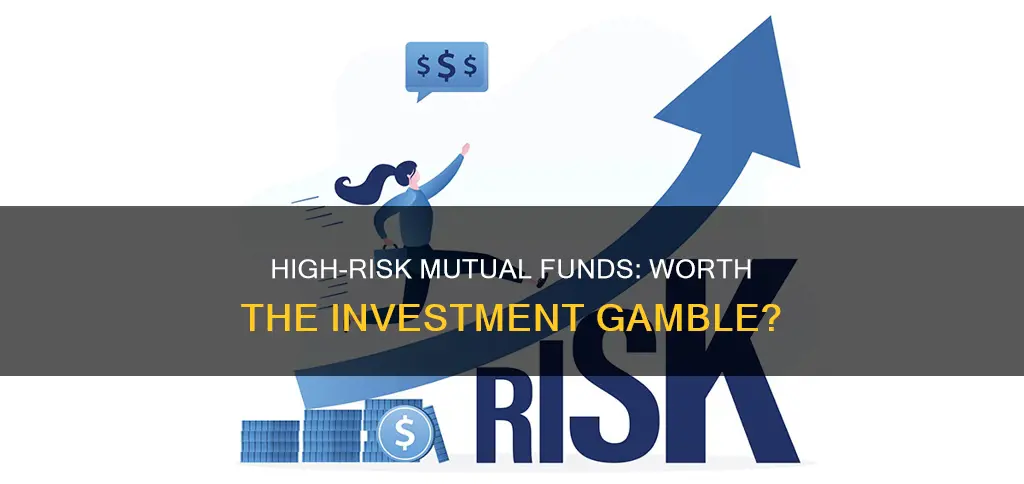
High-risk mutual funds are an investment option for those seeking higher returns and are willing to accept greater risk and volatility. These funds typically invest in volatile assets, such as stocks of emerging companies, commodities, or sectors experiencing significant growth or decline. While they offer the potential for substantial rewards, investors should be prepared for short-term price fluctuations and losses. Before investing, it is crucial to assess your risk tolerance, financial objectives, and time horizon. High-risk mutual funds are generally suitable for investors with a long-term investment horizon, often extending up to 5-10 years. They can provide opportunities for diversification, professional management, and higher returns over time. However, it's important to conduct thorough research and consult financial advisors to ensure that the level of risk is aligned with your investment goals and comfort.
| Characteristics | Values |
|---|---|
| Risk | Higher risk of losing value |
| Returns | Potential for higher returns |
| Investment type | Stocks, equity, debt market, bonds, commodities, real estate |
| Investor type | Long-term horizon, willing to accept volatility, aggressive but patient approach |
| Fund type | Equity funds, growth funds |
| Management | Professional fund managers |
| Taxation | STCG Tax: 15% (holding period <1 year); LTCG Tax: 10% (holding period >1 year) |
What You'll Learn

What are high-risk mutual funds?
High-risk mutual funds are funds that invest in volatile assets, such as stocks of emerging companies, commodities, or sectors experiencing significant growth or decline. These funds carry a higher level of risk compared to other types of mutual funds but also present the potential for substantial rewards. They are designed for investors who are willing to take on more risk in exchange for the potential for higher returns.
High-risk mutual funds are often associated with aggressive investment strategies, targeting above-average growth and outperforming the broader market. While these funds offer the allure of significant returns, they also come with a higher risk of loss. This means that investors need to be comfortable with short-term price fluctuations and potential losses.
These funds are typically suitable for investors with a strong risk appetite and a good understanding of the market and macroeconomic trends. They are also ideal for those with long-term financial goals, such as retirement planning, and are willing to remain invested for an extended period, usually at least five years.
High-risk mutual funds can be further categorised into different types, including balanced advantage schemes, credit risk fund schemes, and equity hybrid fund schemes. These funds predominantly invest in stocks or bonds of developing or growing companies, depending on their specific asset allocation.
It is important for investors to carefully assess their risk tolerance and financial objectives before investing in high-risk mutual funds. While these funds offer exciting opportunities, they are not suitable for everyone, and it is crucial to ensure that the level of risk aligns with one's investment goals and comfort.
Venture Capital's XAI Investment: Who's Leading the Pack?
You may want to see also

What are the benefits?
Investing in high-risk mutual funds can be a great way to boost your portfolio's performance, but it's not without potential drawbacks. Here are some key benefits of investing in high-risk mutual funds:
Higher Returns Potential
High-risk mutual funds typically invest in assets with higher volatility, such as stocks of small-cap companies, emerging markets, or even derivatives. While these investments carry more risk, they also offer the potential for substantial returns over the long term. The higher the risk, the higher the potential reward.
Long-term Capital Appreciation
High-risk mutual funds are designed for long-term investment horizons, typically 5-10 years. This long-term perspective allows investors to ride out short-term market fluctuations and benefit from compounding returns. They are ideal for investors with a patient and aggressive investment approach.
Diversification Opportunities
Some high-risk mutual funds offer diversification across a wide range of assets, including stocks, bonds, commodities, and real estate. This diversification helps to spread risk and potentially reduce overall portfolio volatility. It also provides exposure to specialised markets or sectors that are not easily accessible through traditional investments.
Active Management
High-risk mutual funds are often actively managed by experienced fund managers who closely monitor market trends, conduct research, and adjust the portfolio allocations. This active management can potentially lead to better investment decisions and improved performance compared to passively managed funds.
Tax Benefits
High-risk mutual funds can offer tax advantages, especially for investors in higher income tax brackets. The long-term capital gains tax rate is typically lower than the tax rate on other types of investments, and there may be additional tax benefits depending on the specific fund structure.
Opportunity to Beat Benchmarks
In a positive market cycle, high-risk mutual funds have the potential to outperform benchmarks and deliver superior returns compared to more conservative investment options.
It's important to remember that high-risk mutual funds are not suitable for everyone. They are designed for investors with a high-risk tolerance, a long-term investment horizon, and a good understanding of the market and macroeconomic trends.
IRAs: Investment Funds or Retirement Savings Plans?
You may want to see also

How to assess risk and volatility?
High-risk mutual funds are extremely sensitive to market fluctuations and carry a higher level of risk compared to other types of mutual funds. They are prone to volatility and are susceptible to market fluctuations, especially in emerging industries or volatile sectors.
- Risk Appetite and Investment Goals: Understanding your individual risk tolerance and financial objectives is crucial. High-risk mutual funds are suitable for investors with a strong risk appetite who are comfortable with exposing their portfolio to volatility in pursuit of higher returns.
- Short-Term Price Fluctuations: Be prepared for short-term price fluctuations and losses. Assess the implied volatility of the funds and have a clear understanding of the fund manager's investment style.
- Fund Performance: Gaining insights into a fund's past performance can aid in decision-making. Compare historical returns with those of other peer options to make an informed choice.
- Economic Conditions: High-risk mutual funds are significantly influenced by economic activities and policies. They are highly sensitive to factors such as gross domestic product (GDP), inflation, and interest rate fluctuations. It is important to have a robust risk management strategy in place to safeguard your investments.
- Market-Specific Factors: Investor sentiments play a crucial role in market dynamics. During favourable periods, investor risk appetite increases, driving the funds upward. However, during challenging times, low investor sentiment can lead to a downturn.
- Liquidity Risk: High-risk mutual funds are not very liquid due to their sensitivity. They face large short-term fluctuations, making it challenging for investors to liquidate their assets and exit the fund.
- Investment Horizon: High-risk mutual funds typically offer more significant returns over an extended time horizon, often up to 5-10 years. This is because the underlying bonds and stocks are mostly from companies in their growth phase.
- Diversification: Diversification is a standard feature of high-risk mutual funds, and it helps to reduce the overall risk of the portfolio.
- Fund Type and Asset Allocation: High-risk mutual funds can vary in type, including balanced advantage schemes, credit risk fund schemes, and equity hybrid fund schemes. The specific asset allocation, such as the mix of stocks, bonds, commodities, or sectors, will depend on the type of high-risk mutual fund.
- Tax Implications: Understand the tax implications of investing in high-risk mutual funds, as they can vary depending on the type of fund and the holding period.
- Consultation: Consult with financial advisors or wealth coaches to assess your risk tolerance and determine if high-risk mutual funds align with your investment goals and strategy.
It is important to thoroughly evaluate these factors before investing in high-risk mutual funds to ensure that you are comfortable with the level of risk and volatility involved.
Investment Fund Balance Stagnation: Why It Happens
You may want to see also

What factors influence high-risk mutual funds?
Several factors influence the performance and volatility of high-risk mutual funds. These factors shape their characteristics, performance, and risk profile. Here are some of the key factors:
- Economic Conditions: Actions by the central bank and the government significantly impact high-risk mutual funds. These funds are highly sensitive to factors such as gross domestic product (GDP), inflation, and interest rate fluctuations. A robust risk management strategy is crucial to safeguard investors from potential losses.
- Market-Specific Factors: Investor sentiments play a crucial role in influencing market dynamics and the performance of high-risk mutual funds. During favourable periods, heightened risk appetite among investors can drive these funds upward. However, challenging times may result in a downturn due to reduced investor confidence.
- Market Conditions: Overall market conditions, including economic indicators, interest rates, inflation, and geopolitical events, heavily influence high-risk mutual funds. These funds tend to perform well in bullish markets but can experience significant losses during market downturns or economic crises.
- Investment Strategy: The investment strategy employed by the fund manager is crucial in determining the fund's risk level. Aggressive strategies such as leveraging, short-selling, concentrated portfolios, and investing in volatile assets can increase the fund's risk exposure.
- Asset Allocation: The allocation of assets within the fund portfolio significantly impacts its risk profile. High-risk mutual funds may allocate a large portion of their assets to high-risk securities, such as equities, commodities, or alternative investments, while limiting exposure to more conservative assets.
- Volatility: High-risk mutual funds are inherently more volatile than low-risk funds. Market fluctuations, company performance, industry dynamics, and investor sentiment contribute to volatility.
- Sector and Geographic Exposure: High-risk mutual funds may focus on specific sectors or geographic regions, leading to concentrated exposure and increased risk. Sector-specific factors, such as regulatory changes, technological advancements, or market disruptions, can significantly impact fund performance.
It is important to note that high-risk mutual funds are not suitable for everyone. They are designed for investors with a long-term investment horizon who are comfortable with accepting higher levels of risk and volatility in exchange for the potential for higher returns.
Magazine Investment Funds: Where to Invest Wisely
You may want to see also

Who are high-risk funds suited for?
High-risk mutual funds are suitable for investors with a high-risk appetite who are willing to expose their portfolio to volatility in exchange for higher potential earnings. These funds are best suited to those with an in-depth knowledge of the market and a strong understanding of macroeconomic trends.
High-risk funds typically offer more significant returns over a long time horizon, often extending up to 10 years. This is because the underlying bonds and stocks are mostly of companies in their growth phase. Therefore, investors with an aggressive but patient investment approach may find these funds suitable.
It is important to note that high-risk funds are not suitable for everyone. Before investing, individuals should carefully consider their financial goals, risk tolerance, and capacity to withstand market volatility.
A Beginner's Guide to UAE Mutual Fund Investing
You may want to see also
Frequently asked questions
High-risk mutual funds are funds that invest in volatile assets such as stocks of emerging companies, commodities, or sectors experiencing significant growth or decline. These funds carry a higher risk of loss but also offer the potential for substantial rewards.
High-risk mutual funds offer the potential for higher returns over the long term, diversification, and professional management by seasoned fund managers. They are suitable for investors with a strong risk appetite who are willing to expose their portfolio to volatility in pursuit of higher earnings.
High-risk mutual funds are extremely sensitive to market fluctuations and therefore carry a higher level of risk compared to other types of mutual funds. Investors should be prepared for short-term price fluctuations and losses. It is important to understand your risk tolerance and investment goals before investing in these funds.
To invest in high-risk mutual funds, you should first research different fund options and choose those that align with your investment goals and risk tolerance. Then, open an account with an online investment platform or directly with the asset management company (AMC). Complete the necessary Know Your Customer (KYC) formalities and start investing.







